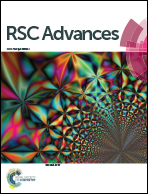Synthesis of highly permeable Fe2O3/ZnO hollow spheres for printable photocatalysis†
Abstract
The creation of a suitable inorganic photocatalyst for use in a scalable coating process is a key step in the development of practical photocatalysis. Herein, we present the deterministic synthesis of mixed-phase Fe2O3/ZnO hollow spheres with submicron pores and demonstrate that ink based on these hollow spheres can be used to manufacture stable photocatalytic papers. The hollow spheres are formed through the self-organization of well crystallized Fe2O3 and ZnO nanoparticles, and they are different from traditional hollow spheres in their innovative submicron pores (width ∼ 500 nm). This morphological feature makes the interior and exterior of the hollow spheres readily accessible and enables them to enrich either small or large pollutants rapidly, as visually determined by the adsorption of the fluorescent molecules and nanoparticles. Moreover, the intimate contact of the wide bandgap ZnO to the narrow bandgap Fe2O3 within the hollow spheres leads to the extension of the light-collection range (spanning the full ultraviolet-visible wavelength) and the emergence of the mixed-phase effects (e.g., enhanced charge separation and transfer). As a conceptual demonstration of the target application of the Fe2O3/ZnO hollow spheres as an ink, we manufacture the photocatalytic paper by the spraying method. The hollow spheres show a perfect geometric match to the cellulose networks within the paper due to the similar dimensions. The tests of the performances of the photocatalytic paper demonstrate that it can efficiently degrade 2,4,6-trichlorophenol (TCP) under the irradiation of the solar light, with a first order rate constant of 0.014 min−1. After ten recycles of the TCP photodegradation, the photocatalytic paper retains constant activity, proving its high stability and durability. As a whole, the photocatalytic paper can be more readily recycled than conventional powder photocatalysts, and should be promising for various environmental applications, including water and air purification.


 Please wait while we load your content...
Please wait while we load your content...